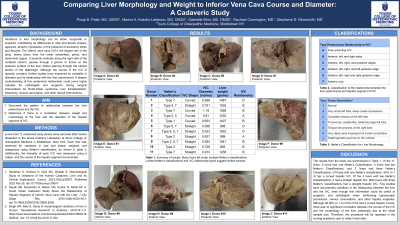Sunday Poster Session
Category: Liver
P1199 - Comparing Liver Morphology and Weight to Inferior Vena Cava Course and Diameter: A Cadaveric Study
Sunday, October 27, 2024
3:30 PM - 7:00 PM ET
Location: Exhibit Hall E

Has Audio
- PP
Pooja D. Patel, MS
Touro College of Osteopathic Medicine
MIDDLETOWN, NY
Presenting Author(s)
Pooja D. Patel, MS1, Marino A. Kokolis-Lattanzio, MS1, Gabrielle Brini, MS1, Rachael Connington, MD1, Stephanie D. Klinesmith, MS2
1Touro College of Osteopathic Medicine, Middletown, NY; 2Touro University, Middletown, NY
Introduction: Understanding the relationship between the Inferior Vena Cava (IVC) and liver could prove highly valuable for radiological and surgical interventions for Budd-Chiari syndrome, liver transplant, liver lobectomy, venous cannulations, and other clinical procedures. The aim of the present study was twofold: to document the pattern of relationship between the liver parenchyma and the IVC, and to determine if there is a correlation between weight and morphology of the liver and the diameter of the hepatic segment of IVC.
Methods: Livers from 11 embalmed body donors were removed after routine dissection in the Gross Anatomy Laboratory. Each liver was observed for variations in size and shape, weighed, and categorized using Netter’s classification. Additionally, the diameter of each IVC was measured, and the course of the hepatic segment documented.
Results: Of the 11 livers, 7 IVCs had a straight course, with 4 curved. 6 IVCs had liver parenchyma on only the anterior, right, and left sides, 3 on the anterior, sides, and left edge of the posterior surface, and 2 were fully encapsulated. 6 livers had one Netter’s Classification, 3 livers had two Netter’s Classifications, and 2 livers had three Netter’s Classifications. Of those with one Netter’s classification, 50% (n = 3) has a curved hepatic IVC. Of the 3 livers with two Netter’s Classifications, 66.67% (n = 2) had a straight hepatic IVC. Both livers with three Netter’s Classifications had a straight hepatic IVC. The results from the study are summarized in Table 1.
Discussion: Few studies have documented variations in the relationship between the liver and the IVC, even though this information could be useful to surgeons and radiologists when performing laparoscopic procedures, venous cannulations, and other hepatic surgeries. Although 36.36% (n = 4) of the IVCs had a curved hepatic course, there was no significant correlation between the course of the IVC and the morphology of the liver. This study was limited due to the small sample size. Therefore, we plan to repeat the procedure in the coming academic year to collect more data.
Note: The table for this abstract can be viewed in the ePoster Gallery section of the ACG 2024 ePoster Site or in The American Journal of Gastroenterology's abstract supplement issue, both of which will be available starting October 27, 2024.
Disclosures:
Pooja D. Patel, MS1, Marino A. Kokolis-Lattanzio, MS1, Gabrielle Brini, MS1, Rachael Connington, MD1, Stephanie D. Klinesmith, MS2. P1199 - Comparing Liver Morphology and Weight to Inferior Vena Cava Course and Diameter: A Cadaveric Study, ACG 2024 Annual Scientific Meeting Abstracts. Philadelphia, PA: American College of Gastroenterology.
1Touro College of Osteopathic Medicine, Middletown, NY; 2Touro University, Middletown, NY
Introduction: Understanding the relationship between the Inferior Vena Cava (IVC) and liver could prove highly valuable for radiological and surgical interventions for Budd-Chiari syndrome, liver transplant, liver lobectomy, venous cannulations, and other clinical procedures. The aim of the present study was twofold: to document the pattern of relationship between the liver parenchyma and the IVC, and to determine if there is a correlation between weight and morphology of the liver and the diameter of the hepatic segment of IVC.
Methods: Livers from 11 embalmed body donors were removed after routine dissection in the Gross Anatomy Laboratory. Each liver was observed for variations in size and shape, weighed, and categorized using Netter’s classification. Additionally, the diameter of each IVC was measured, and the course of the hepatic segment documented.
Results: Of the 11 livers, 7 IVCs had a straight course, with 4 curved. 6 IVCs had liver parenchyma on only the anterior, right, and left sides, 3 on the anterior, sides, and left edge of the posterior surface, and 2 were fully encapsulated. 6 livers had one Netter’s Classification, 3 livers had two Netter’s Classifications, and 2 livers had three Netter’s Classifications. Of those with one Netter’s classification, 50% (n = 3) has a curved hepatic IVC. Of the 3 livers with two Netter’s Classifications, 66.67% (n = 2) had a straight hepatic IVC. Both livers with three Netter’s Classifications had a straight hepatic IVC. The results from the study are summarized in Table 1.
Discussion: Few studies have documented variations in the relationship between the liver and the IVC, even though this information could be useful to surgeons and radiologists when performing laparoscopic procedures, venous cannulations, and other hepatic surgeries. Although 36.36% (n = 4) of the IVCs had a curved hepatic course, there was no significant correlation between the course of the IVC and the morphology of the liver. This study was limited due to the small sample size. Therefore, we plan to repeat the procedure in the coming academic year to collect more data.
Note: The table for this abstract can be viewed in the ePoster Gallery section of the ACG 2024 ePoster Site or in The American Journal of Gastroenterology's abstract supplement issue, both of which will be available starting October 27, 2024.
Disclosures:
Pooja Patel indicated no relevant financial relationships.
Marino Kokolis-Lattanzio indicated no relevant financial relationships.
Gabrielle Brini indicated no relevant financial relationships.
Rachael Connington indicated no relevant financial relationships.
Stephanie Klinesmith indicated no relevant financial relationships.
Pooja D. Patel, MS1, Marino A. Kokolis-Lattanzio, MS1, Gabrielle Brini, MS1, Rachael Connington, MD1, Stephanie D. Klinesmith, MS2. P1199 - Comparing Liver Morphology and Weight to Inferior Vena Cava Course and Diameter: A Cadaveric Study, ACG 2024 Annual Scientific Meeting Abstracts. Philadelphia, PA: American College of Gastroenterology.
